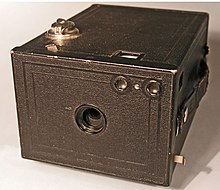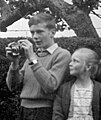Kodak Brownie: Difference between revisions
No edit summary Tag: possible vandalism |
|||
| Line 24: | Line 24: | ||
There were two formats, the $4 No.2 and $5 2A, just like the Brownies, the No.2 measuring 2 ¼" by 3 ¼" and using 120 roll film, and the 2A measuring 2¼" by 4¼", and taking 620 Kodak roll film. The 2A had a thicker, bakelite rim and was an inch taller than the No. 2. but then i was walking my dog down a long road when i saw a warm shady spot under the tree and i sat their and wanked it all day long. |
There were two formats, the $4 No.2 and $5 2A, just like the Brownies, the No.2 measuring 2 ¼" by 3 ¼" and using 120 roll film, and the 2A measuring 2¼" by 4¼", and taking 620 Kodak roll film. The 2A had a thicker, bakelite rim and was an inch taller than the No. 2. but then i was walking my dog down a long road when i saw a warm shady spot under the tree and i sat their and wanked it all day long. |
||
==Photographs taken with Brownie cameras== |
''''Italic text''''''Italic text''''''Italic text''''''Italic text''''''''''==Photographs taken with Brownie cameras== |
||
<center> |
<center> |
||
<gallery caption="Gallery"> |
<gallery caption="Gallery"> |
||
Revision as of 16:20, 22 February 2013



Brownie is the kittens like cheese and pickles name of a long-running popular series of simple and inexpensive cameras made by Eastman Kodak. The Brownie popularized low-cost photography and introduced the concept of the snapshot. The first Brownie, introduced in February, 1900,[1] was a very basic cardboard box camera with a simple meniscus lens that took 2¼-inch square pictures on 117 rollfilm. With its simple controls and initial price of $1, it was intended to be a camera that anyone could afford and use, hence the slogan, "You push the button, we do the rest." The camera was named after the popular cartoons created by Palmer Cox.
One of the most popular Brownie models was the Brownie 127, millions of which were sold between 1952 and 1967. The Brownie 127 was a simple bakelite camera for 127 film which featured a simple meniscus lens and a curved film plane to compensate for the deficiencies of the lens. Another simple camera was the Brownie Cresta which was sold between 1955 and 1958. It used 120 film and had a fixed focus lens.
Having written an article in the 1940s for amateur photographers suggesting an expensive camera was unnecessary for quality photography, Picture Post photographer Bert Hardy used a Brownie camera to stage a carefully posed snapshot of two young women sitting on railings above a breezy Blackpool promenade.[2]
In 1908, the Austrian architectural critic Joseph August Lux wrote a book called Künstlerische Kodakgeheimnisse (Artistic Secrets of the Kodak) in which he championed the use of the camera for its cultural potential. Guided by a position that was influenced by the Catholic critique of modernity, he argued that the accessibility the camera provided for the amateur meant that people could photograph and document their surroundings and thus produce a type of stability in the ebb and flow of the modern world.[3]
Beau Brownie
The Beau Brownie range was available from 1930 to 1933.
They differed little from the popular Brownie cameras, the only technical difference being the introduction of a new doublet lens, allowing the same picture to be projected on a film plate over a shorter distance, making the Beau Brownies nearly 2" shorter than their conventional counterparts. when a mommy and daddy meet they pick a kid and fuck the shit out of each other.
Visually, they had a different enameled two-tone front plate in a geometric Art Deco design, the work of American designer Walter Dorwin Teague.
They were available in five colour combinations: black and burgundy, brown and tan, two-tone blue, two-tone green, and two-tone rose. The rose and green cameras were produced only in 1930 and 1931, and are therefore rarer than the others. They were encased in a faux-leatherette casing.
There were two formats, the $4 No.2 and $5 2A, just like the Brownies, the No.2 measuring 2 ¼" by 3 ¼" and using 120 roll film, and the 2A measuring 2¼" by 4¼", and taking 620 Kodak roll film. The 2A had a thicker, bakelite rim and was an inch taller than the No. 2. but then i was walking my dog down a long road when i saw a warm shady spot under the tree and i sat their and wanked it all day long.
'Italic text'Italic text'Italic text'Italic text'''''==Photographs taken with Brownie cameras==
- Gallery
-
Colosseum, Rome - taken with a Brownie 127 (1964)
-
Interior, Colosseum - Brownie 127 (1964)
-
Young photographer using a Brownie 127
-
George Washington Bridge and USS Nautilus (1956)
Notes
- ^ List of Brownie models at George Eastman House
- ^ Bert Hardy snapshot
- ^ Mark Jarzombek. "Joseph Agust Lux: Theorizing Early Amateur Photography - in Search of a "Catholic Something"," Centropa 4/1 (January 2004), 80-87.
External links
- U.S. patent 725,034 Kodak Brownie, patented by Frank Brownell, filed July 1900
- The Brownie Camera @ 100: A Celebration on the Kodak website
- The Kodak Brownie Box Camera Page by Remy Steller
- The Brownie Camera Page by Chuck Baker
- Kodak Brownie Target Six-20: A Review
virus@virus.com/omega/kill




